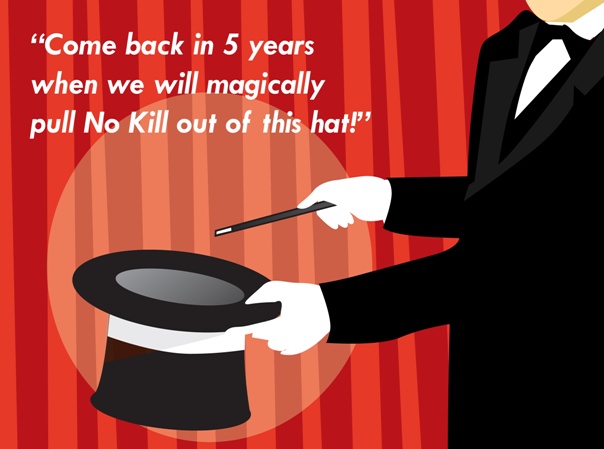
In 2003, surrounded by fanfare and what would eventually amount to tens of millions of dollars flowing into their coffers, the Mayor’s Alliance for New York City’s Animals announced a plan to make New York City shelters No Kill by 2008. This was not the first time it had been promised. Earlier, New Yorkers had been promised a No Kill city by 2005. Within a few years, the Mayor’s Alliance realized they were failing. Publicly, they assured everyone they were “on track” to achieve it.
In 2007, they announced a new five-year plan, promising No Kill by 2012. And, yet again, despite public assurances they were “on track,” in 2010—as if the previous five-year plans were never announced—they rebranded the current one as a “ten-year” plan, promising No Kill in New York City by 2015. Once again, they claim to be “on track” to achieve it, even while the New York City municipal shelter system was then and is now a den of rampant neglect, abuse, and systematic killing.
Anyone familiar with the systematic culture of failure (by design) of the New York City pound system, and the callous indifference of groups like the Mayor’s Alliance and ASPCA, knows that 2015 will also come and go, and far from No Kill, the groups will announce a new five year No Kill plan; and whatever the results, the private acknowledgment of failure will be ignored in favor of the public claims that they will be “on track” to achieve it at some new date in the future. No matter, with resources coming in from the ever-willing-to-help animal-loving American public, to groups like the Mayor’s Alliance and ASPCA there’s no downside.
In fact, while the Mayor’s Alliance is taking in millions by claiming a serial string of five year plans, other groups are realizing that claiming a five year plan to No Kill will not only fend off criticism about killing today—kicking the can of accountability into the future—but is very lucrative. As a result, they are announcing five year plans of their own, promising the public that the light is at the end of the five-year tunnel, if the public just digs deeper and donates more. Not to be outdone, Maddie’s Fund is also claiming—as part of its own cycle of fail-to-deliver five year plans—that the whole nation will be No Kill by 2015; that every single shelter in every single community in every single state will have ended the killing of healthy and treatable animals by achieving save rates of roughly 95%.
Like New York City (as well as Contra Costa County in California, the entire state of Utah, the City of Los Angeles, San Antonio, Texas, Maricopa County in Arizona, and everywhere else that we’ve been promised a five year plan to No Kill), it won’t happen. It won’t happen in New York City (at least under the current leadership), it won’t happen in other communities promising five year plans for success, and it won’t happen nationally by 2015. In fact, it has never happened.
Not because it can’t happen; it can. We can be a No Kill nation today. Five year No Kill plans don’t work because they are not supposed to. They are nothing more than a means of stifling criticism or raising money by creating the impression that plans are underway that will someday bring the killing to an end. Meanwhile, the action necessary to actually make No Kill happen—reforming the shelter—is never taken. People are asked to spay/neuter more, to adopt more, not to surrender their animals, and here’s the rub—to donate a lot more—but the shelter is let off the hook. In fact, as part of the five year collaboration, you can’t even criticize or ask for policy, program, or personnel changes at the shelter, because even though this is very place where the needless killing occurs, we are now told they are a “partner” in the five year No Kill plan. And so the five years come and go and the killing continues, while those involved keep their fingers crossed that everyone has forgotten the empty promises that made them very rich in the process, so at the end of five years, they can start the whole process over again.
The truth is it doesn’t take five years to implement alternatives to killing. It doesn’t take five years to set up a foster program, to recruit volunteers, or to set up offsite adoption venues. All of these things can be done in a matter of days, weeks, months, whatever needs dictate to prevent killing. No Kill requires action, not endless planning and five years of fundraising. In fact, the communities across the country that have ended the killing of healthy and treatable animals, saving well in excess of 90% of all intakes, did so virtually overnight; as new leadership took over the shelter and did what the former refused to do: comprehensively implement alternatives to killing.
Austin, Texas, for example, has a higher per capita intake rate than Los Angeles which recently embraced yet another five year plan to No Kill. Unlike Los Angeles, city council members in Austin gave shelter leadership a maximum of two years, removed the director who was the primary roadblock to No Kill success, and unanimously embraced a shelter reform plan to mandate the programs and services of the No Kill Equation. It took a few short months following the forced departure of the ASPCA-backed regressive director to achieve a better than 90% save rate. Not five years. Not even the two years allotted by the Austin City Council. It happened virtually overnight because a great thing happens when you remove a regressive director, reform the shelter, and put in place alternatives to the killing: the killing stops. And it has happened across the country.
Los Angeles has a per capita intake rate that is one-fourth that of Washoe County, Nevada, which achieved No Kill within a year of its initiative. New York, with its endless parade of failed five year plans, has still not achieved it despite having the single largest adoption market in the nation and a per capita intake rate one-eighth of Washoe County. Unlike Los Angeles and New York, Washoe County is not the center of our nation’s wealth. It does not have organizations taking in tens of millions of dollars per year. But New York does. And so does Los Angeles. Like New York, Los Angeles is home to tremendous wealth and resources. And Los Angeles has one of the most generously funded shelter systems in the nation. With 9,452 dogs killed and 13,467 cats killed in 2011 in a city of 3.8 million people, the achievement of a No Kill Los Angeles should be achieved this year. In fact, comparing adoption rates with Reno and adjusting for population, Los Angeles City shelters should be adopting out 87,000 animals a year, more than total impounds. So why should it take five times as long with a fraction of the problem?
Because five years is a mighty long time—just long enough for memories of bold promises of No Kill to fade and be forgotten; and just long enough for the needless body county of animals to sew such despair that another promised five year plan will again be greeted with enthusiasm and support; enthusiasm and support that will result in lots and lots of money.

For further reading:
Atten-Hut: Sgt. Bailey in Command